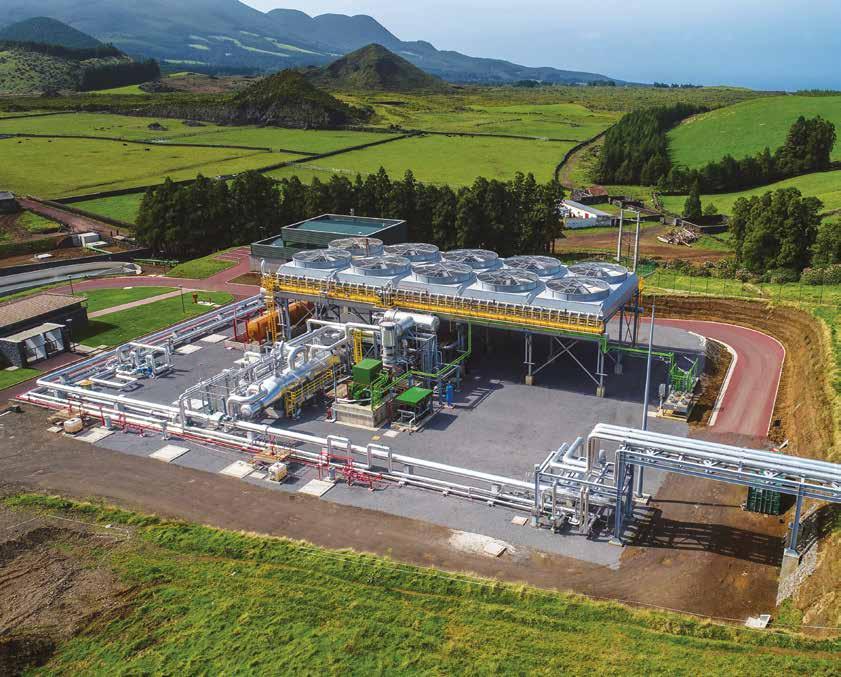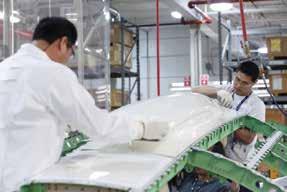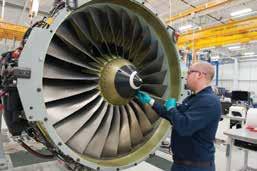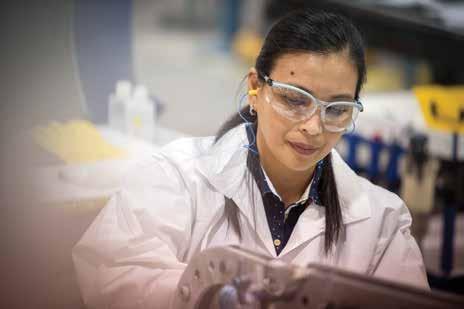
11 minute read
Manufacturing. Revolutionized
Many manufacturers in Alberta are getting serious about being lean and green. How that looks, however, can be different for every company.
Even companies servicing and supplying the manufacturing sector are getting behind the movement, and they’re ready to work with manufacturers to tackle environmental challenges head-on.
Advertisement
Meet three companies who are taking the message to heart and making a positive difference for industry and consumers across the province and beyond.
PHOTO CREDIT: JANA HANOVA / SWIRLTEX
Swirltex
When you think of wastewater, you might not necessarily think ‘innovation’ at first. Calgary’s Swirltex is trying to change that.
Dealing with wastewater – such as sewage effluent, produced water from oil and gas extraction, process water in food & beverage production, and even pond water – is an absolute necessity in today’s industrial environment. While the need to effectively manage wastewater has not significantly changed, Swirltex has set out to change how companies do it and help them do so more efficiently.
Swirltex isn’t a new filter material. Rather, it’s a new way to move the wastewater through existing filtration media.
“We change the way the water moves before it gets to the filter, and we do this using less power than a traditional system,” says Swirltex CEO, Melanie McClare.
“The system separates solids and liquids based on buoyancy,” says McClare. “We manipulate the contaminants in the water to keep them away from the filter membrane, and this lets more of the water through and keeps the filter cleaner longer.”
McClare says, “with our technology, we’re able to deploy membranes where they were previously uneconomical. We can use fewer membranes to achieve full results, and we can process more water for the same amount of input.”
Swirltex is still in the early stages of the business, but McClare says the company is ready to take on more and more challenges.
“We’re selling wastewater treatment as a service to companies, as opposed to the traditional capital expenditure for customers. We can deploy our systems seasonally, if needed, and we can come in to do a retrofit on existing systems and provide a polish on the back end of existing infrastructure.”
It was around 2015 when Calgary’s Thomas Mo decided to do something about all the mass-produced throwaway clothing – often sold to tourists - that he found in shops across Alberta.
Having garments manufactured in low-cost jurisdictions, emblazoned with imagery and slogans from his home province in other offshore locations, then sold for rockbottom prices in local shops just didn’t sit right with Thomas or his peers.
It was Thomas’s desire to change this situation that was the genesis of Alberta Apparel.
“It was a no brainer to source Canadian-manufactured clothing,” says Mo.
About 80 per cent of the company’s expenditures are in Canada, and that’s about the highest proportion that can be reasonably done in this country, according to Mo. “Textile manufacturing is about volume – unless you’re doing something really boutique and niche,” says Mo. “There used to be textile plants in Canada, but the industry has shifted to about 31,000 residents and over 1,500 businesses. With one of the lowest tax regimes in Western Canada, its costcompetitive land options, proximity to resources, a skilled labor force and direct access to key markets and supply chains north and west of the region, Parkland County is ideally suited for clean/ green manufacturing. One such company, Genics, based in the city of Acheson, produces safe and environmentally friendly wood treatment products that extend the service life of utility poles.
Several Federal and Provincial financial mechanisms are today available to support the sector. Alberta Innovates, the province’s largest research and innovation agency, for example, helps fund to commercialize existing and new ventures within the sector. Over the next three years, the agency will be distributing $50 million from the industry-funded Technology Innovation and Emissions Reduction (TIER) system intended to grow the province’s cleantech industry and cut emissions. With additional dollars invested from industry, this support will total almost $200 million.
Since September, Alberta’s government has already announced TIER funding for methane programs, carbon capture, utilization and storage programs, flood resilience programs, and the construction of a renewable natural gas and a clean fertilizer and every brand is buying from the same small number of factories.”
While the raw material for many of their garments still comes from abroad, Mo explains that all the design, cutting, sewing, decoration, and packaging is done in Canada.
“The high value work is being done domestically,” says Mo. “We’re keeping as much of the production as close as possible to the customer.”
Asked about his company’s ethos, Mo says, “It’s important to us to be local and to educate people on not just the clothing industry, but the Canadian clothing industry and manufacturing industry overall.”
Instead of trying to compete with the ‘fast fashion’ brands like H&M, Zara, and other international behemoths, Mo says Alberta Apparel is finding a niche in the higher end of the market.
“Our products are going to be a bit more expensive because they’re made in Canada, but they’re definitely much higher quality and will last more than a single season,” explains Mo.
“Our customers are our ambassadors, and they know the difference that Canadian-made clothing can make from a financial and environmental standpoint. The pieces they’re buying are going to be a part of their wardrobes for a number

PHOTO CREDIT: THOMAS MO / ALBERTA APPAREL
SPONSORED CONTENT
Clean and green manufacturing is finding a home in Parkland County and throughout Alberta
Located 20 miles west of Edmonton, Parkland County is home
of years.” facility in Lacombe which will transform agricultural and plant waste into organic fertilizer, cutting the equivalent of 8,500 cars in emissions.
Alberta today is no longer just about oil and gas; thanks to local government and industry support, heavy investments are being made to support a sector the Province views as a future economic driver. Parkland County is here to welcome Clean and Green companies seeking an ideal location to do business.” said Robert Fernandez, Director of Economic Diversification, Parkland County.

Waste isn’t just the tangible stuff that ends up in a bin or down the drain; it includes things we cannot see but can definitely feel: heat.
Gray Alton, Vice President of Project Development with Terrapin explains that excess heat from industrial processing is a huge opportunity for capture and transformation.
“Globally, we’re wasting at least 290,000 petajoules of heat every year,” says Alton. “Globally, we use more than 530,000 petajoules annually to generate the energy we need as a society, so we’re really only getting full value from about 50 per cent of the energy that we use.” Editor’s note: Just to be clear on the scale we’re talking about, the numbers in the paragraph above - if written out fully – would be 21 digits long (i.e., 290,000,000,000,000,000,000 joules). That’s a LOT of energy, both generated and wasted.
Terrapin works with companies who have significant waste heat in their processes and/or facilities to match them with technology to capture the heat and transform it into the most efficient and effective mode, all the while bringing in financing partners to pay for the technology in the customer’s plant.
“Depending on the specific situation, we may bring in a technology to simply capture the heat and redistribute it via a district heating system,” says Alton. “Alternatively, we can take the heat and use it to generate electricity and feed it into the larger grid, offsetting what might usually be generated from fossil fuels.”
“We look for opportunities where a company’s waste heat might be available 85 to 90 per cent of the time, and that lets us use the waste heat as a baseload generation source – which is usually what coal is used for on the grid,” explains Alton.
“We work with each client to find a number of heat resources within their processes, and then we prioritize the sources that will give everyone the biggest win,” says Alton.
“There’s tonnes of excess heat out there, but not all of it can be captured and efficiently transformed into other forms of energy,” Alton says. “It’s usually the furnaces, industrial process heating, and other ‘big’ sources that will make the most sense.”
“While we’re not necessarily reducing emissions directly in each client’s facility, we are helping to get more value from each unit of energy and its associated emissions,” explains Alton. “Reducing emissions intensity is still very positive.”

Manufacturing. Revolutionized.
Canada is poised to thrive in the new manufacturing economy, Prairie companies can lead the way
By Rob MacLeod
The past year can be characterized by a single word: change.
We’ve changed the way we do business, how we stay connected, and how we see global value chains.
It is important to note, however, that many of these changes were afoot long before the pandemic put the global economy in a stranglehold. The COVID-19 crisis aggravated business conditions that were already challenging manufacturers such as weakening global demand, concerns around supply chain resilience, falling oil prices, growing protectionism, and heightened cybersecurity risks.
At the onset of the pandemic, the Canadian economy saw a contraction of 20 per cent – a period that was especially challenging for manufacturers, characterized by a drop in output of one-third.
Manufacturing operations around the world are being disrupted not only by the impacts of the pandemic, but also by intense global competition, personalized customer expectations, stringent regulatory environments, and rapid advances in technology.
Whether you call it Industry 4.0, advanced manufacturing, or the fourth industrial revolution, one thing is clear – the business of manufacturing is changing and the pandemic has served to accelerate the agents of change – smart technology platforms, connected factories, near-shoring, and supply chain traceability to name a few.
While changes to the global operating environment will bring significant disruption, Canadian manufacturing is well positioned to respond and take advantage of new opportunities.
The Canadian Opportunity
Canada has a strong foundation in advanced production technologies and the essential tools like artificial intelligence, machine learning and digital technologies that constitute a modern manufacturing operation.
Canada is also home to worldrenowned research centres with leading capabilities in strategically important areas like advanced materials and next generation computing.
Although manufacturing output is down, recent data shows that, as of September, Canada has seen the fastest rate of manufacturing productivity growth in 20 years. Our advantage lies in our pool of diversified and agile manufacturing capabilities led by a highly capable, modern workforce.
The key to our success is in our ability to connect the dots and foster a culture of operational excellence.
While changes to the global operating environment will bring significant disruption, Canadian manufacturing is well positioned to respond and take advantage of new opportunities.
About NGen
NGen is the industry-led, nonprofit leading Canada’s advanced manufacturing supercluster, which is founded on the principle that the transformation to advanced manufacturing will enrich the lives of Canadians, delivering better products and good jobs while generating the economic growth essential to a better future.
NGen is committed to building world-leading advanced manufacturing capabilities in Canada through collaborative partnerships that integrate our research, technology, and manufacturing strengths to accelerate the development, deployment, and adoption of new technologies in manufacturing.
Canada is a manufacturing nation that can claim a position of global leadership by focusing our efforts on a shortlist of priorities.
Industry-led investments
Canadian innovation policy has long focused on early-stage technologypush incentives in lieu of supporting the downstream commercial applications of new tech. While this approach has helped foster a vibrant technology and start-up community, it has also resulted in stranded intellectual property and has left start-ups to find their own ways to commercialize – often through offshoring or foreign acquisitions which are accompanied by an exodus of taxpayerfunded innovations whose economic benefits are reaped beyond our borders.
Superclusters are unique in their demand-pull approach to
commercialization. By focusing on strategic, market-driven opportunities that involve the industrial applications of new technologies and processes, superclusters are simultaneously de-risking technology development and deployment while incentivizing Canadian innovators to grow their businesses at home in Canada. This approach is connecting both the users and the producers of technology to encourage innovation driven by market needs.
In the new manufacturing economy, world-leading solutions will not be built in silos.
C
M
Y
Connections & Collaboration
In the new manufacturing economy, world-leading solutions will not be built in silos.
The advent of Industry 4.0 means that manufacturers are becoming solutions providers. A majority of Canadian manufacturers do not collaborate meaningfully or on a regular basis, but with more integrated supply chains and the outsourcing of inputs and services, innovation partnerships are transforming supply chains into value networks.
Key to Canada’s success will be incentives that promote collaborative innovation partnerships which leverage strengths across industry sectors to develop more valuable, integrated solutions that can be commercialized around the world.
CM
MY
CY
CMY
K manitobaaerospace-halfpage_PRINTFILE.pdf 1 2020-11-27 7:18 AM






